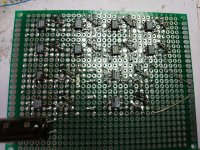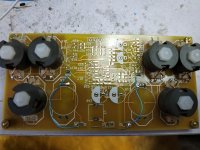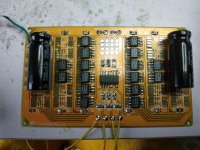Are four paralleled DAC chips enough?
Where's the sweet spot in paralleling DACs? I don't know the answer to this one yet but I'm at present setting up an experiment with 8 paralleled chips to see if there's a significant improvement over 4. To try to keep relatively the same circuit conditions I've built a filter which operates at half the impedance so that the DAC output compliance range is approximately the same. The I/V stage has 5 paralleled opamps to reduce the noise - running a lower Z filter increases the noise so the paralleling is an attempt to offset that.
Where's the sweet spot in paralleling DACs? I don't know the answer to this one yet but I'm at present setting up an experiment with 8 paralleled chips to see if there's a significant improvement over 4. To try to keep relatively the same circuit conditions I've built a filter which operates at half the impedance so that the DAC output compliance range is approximately the same. The I/V stage has 5 paralleled opamps to reduce the noise - running a lower Z filter increases the noise so the paralleling is an attempt to offset that.
Attachments
I'm not going for even numbers, rather powers of two as then the math about the noise I can do in my head. Do you think 9 will sound different from 8 apart from being a touch louder?
This DAC surprised me in that it worked first time and it didn't even take a second of listening to notice that something had changed. I'm listening on headphones (HD6XX) and the effect is to bring the listener closer to the sources of the sound - a more 'on-stage' experience rather than a perspective from a few rows back. It seems to 'wrap around' the soundstage more than the 4 DAC version and this effect is consistent on different recordings. I shall next experiment with crossfeed to see if I can move the image more forward.
This DAC surprised me in that it worked first time and it didn't even take a second of listening to notice that something had changed. I'm listening on headphones (HD6XX) and the effect is to bring the listener closer to the sources of the sound - a more 'on-stage' experience rather than a perspective from a few rows back. It seems to 'wrap around' the soundstage more than the 4 DAC version and this effect is consistent on different recordings. I shall next experiment with crossfeed to see if I can move the image more forward.
It just sounds better overall. Remember I mentioned to you once about asymmetrical supplies for op amp ? I have found that Odd numbers somehow sounds better, even for caps when in parallel 3 sounds better then 4 etc. Many are going to flame me for my comments but I always experiment & think out of the box. It's just my findings & perhaps for my own amusement too. Lol
Cheers
Cheers
Nope its comes with 1, there was these rave discussion about parallel sounds better so that got me curious & I played with it but only got to 4 dac's. Play with the passive I/V too. Been too long can't recall resistors value tested. Im not the scientific kind who wants to dig into knowing why. Like caps even generic brands, they all will sound different, specs may look the same but results aren't & Im not gonna get myself all wrap up as to why.
I know that your more scientific in your approach & that's very good Richard, like your I/V, if you were to try say a AB carbon resistor, you'll fall off the chair asking why so much difference, this is not to say that it'll sound great but you'll hear the big changes & why so, this becomes the unexplainable part & spec says AB carbon wazzz very noisy, values drifts etc but ??????
Cheers
I know that your more scientific in your approach & that's very good Richard, like your I/V, if you were to try say a AB carbon resistor, you'll fall off the chair asking why so much difference, this is not to say that it'll sound great but you'll hear the big changes & why so, this becomes the unexplainable part & spec says AB carbon wazzz very noisy, values drifts etc but ??????
Cheers
In my I/V I'm only using the poorest grade of resistor (thick film). It sounds fine to my ears so no desire to fiddle with that, besides with parallel I/V stages that gets to be a LOT of I/V resistors to change 
This 8 parallel DAC is extremely engaging, when my wife listened to it she got lost in the music and forgot she was supposed to be telling me about any faults she heard
This 8 parallel DAC is extremely engaging, when my wife listened to it she got lost in the music and forgot she was supposed to be telling me about any faults she heard
We have different focuses - you're interested in getting the best sound for your own system. So given that, no real need to optimize what you have for BOM cost. But seeing as I want a design which is as cheap as possible, I won't fit naked Vishays for every single resistor or Black Gates for every cap, I need to understand where in a circuit resistor and cap quality matters. Hence my 'why?' mentality.
- Home
- Source & Line
- Digital Line Level
- lingDAC - cost effective RBCD multibit DAC design


